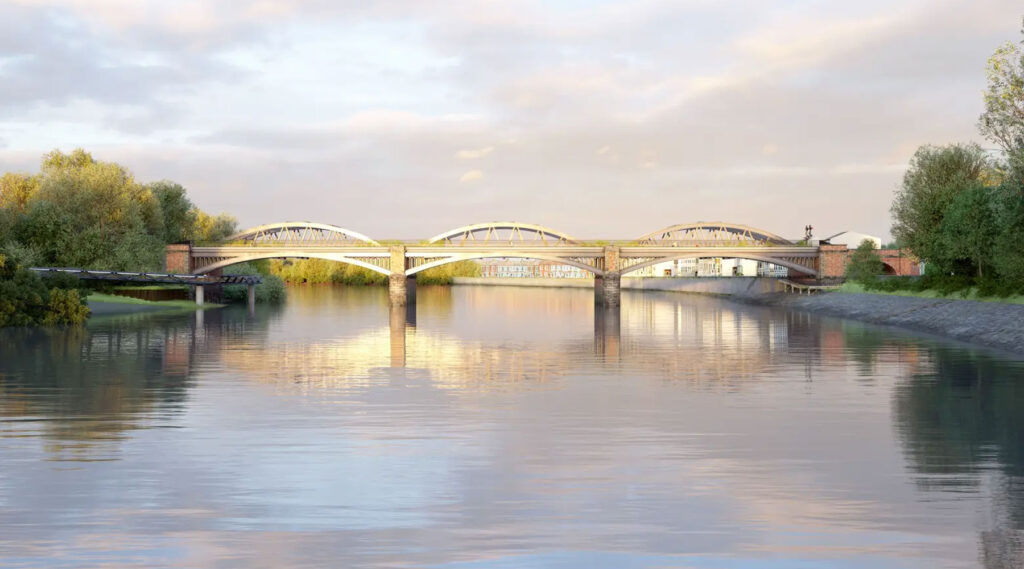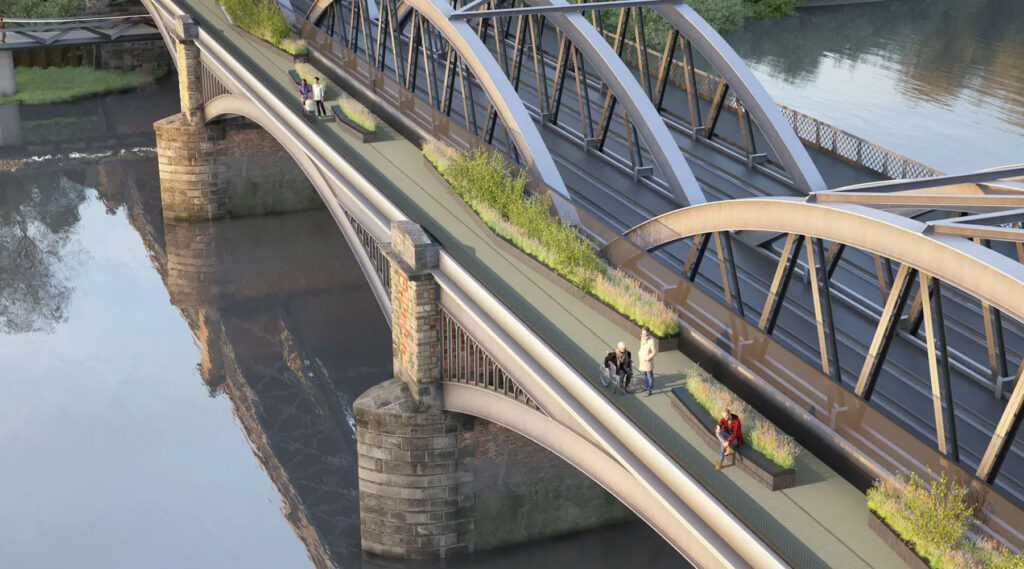A section of the Thames with few bridges could become a lot easier for pedestrians and cyclists to cross if plans to convert a disused railway bridge for pedestrian use go ahead.
The disused bridge crosses the Thames at Barnes, which may confuse some people as the bridge there is in daily use by trains. That’s because little noticed by most people, this is actually two bridges. The railway bridge in use today was built in the 1890s, as a replacement for an earlier cast iron bridge that was built in 1849. That older disused bridge sits right next to the railway bridge, even though few people realise they are two separate structures.
There is an existing walkway on the live railway bridge side, but it’s narrow and lacks any step-free access options. It’s also, in theory, not open to cyclists.
A plan, supported by both councils on either side of the river is to open up the disused bridge as a wider pedestrian and cycle route, with gentle gradient slopes on either side to provide an accessible and pleasant way to cross the river. Another benefit is that on the southern side, the slope up to footbridge will also offer step-free access to the outward-bound platform at Barnes Bridge station that’s next to the railway bridge.
As the bridge will be open to cyclists, to discourage speeding while maintaining at least 2 metres of width along the route, the footpath meanders around planters and integrated seating.
The south side in Barnes is largely residential, while the north side in Hounslow is mostly fields and sports facilities. The river walk on the north side is also being upgraded at the moment with a new pedestrian path under the railway bridge to make that route easier to use. The architects who developed that new pedestrian link are the same as the ones working on this new project to open up the disused railway bridge, Moxon Architects, so they’re familiar with the area.
They also have support from Network Rail to carry out the plans.
The organiser’s official website says that the new bridge will also offer views of the annual Boat Race, as the existing narrow footbridge is closed on Boat Race day to prevent overcrowding.
The current estimate is that the project will cost around £3 million to complete. The bulk of the costs are for the step-free access at either end of the railway bridge, and then there’s landscaping work, moving some power cables from the live railway and restoring a Victorian turnstile at the Hounslow end. Studies have already been carried out on the structure, so they don’t anticipate any huge surprises there.
Subject to securing the funding, they expect to open the disused railway bridge to the public in 2026.









This all sounded very positive, right up to here:
“As the bridge will be open to cyclists, to discourage speeding while maintaining at least 2 metres of width along the route, the footpath meanders around planters and integrated seating.”
Is it supposed to be a new active travel link, or a park? Don’t get me wrong, the idea of planters and benches sounds lovely – but if this is meant to encourage more cycling then deliberately designing the route so cyclists have to weave in-between obstacles sounds like a very bad idea. They’ll already have to watch out for pedestrians.
Imagine if the proposed new Lower Thames Crossing tunnel – expected to be built to near-motorway standard – came with traffic-calming chicanes, it would be clear that the designers didn’t know what they were doing… And yet cyclists seem to be treated just like that here – as an inconvenience. Also, how is anyone who is partially-sighted or blind supposed to navigate this bridge if the position of the safe walking route keeps meandering all over the bridge?
If the goal really is to improve cross-river active travel then it should be made easier and more pleasant for everyone to use it, but just fully-sighted pedestrians.
More the realistic understanding that while the new bridge will be wider than the old, it’s not wide enough to have segregated cycle lanes and that there is sadly a tendency for a sizeable minority of cyclists to speed in pedestrian spaces – which is dangerous.
Far better to be aware of that and design the bridge to make it usable for everyone, even if that means a small number of cyclists who want to speed along the bridge are unable to do so.
The vast majority will be happy though.
I’d be very surprised if the Lower Thames Crossing didn’t come with average speed cameras and a limit lower than 70 simply because the designers DO know what they’re doing and what the challenges will be to keep it safe with the ever decreasing number of Traffic Police.
How about vertical segregation? Put the pedestrians on the level of the current bridge, and the cyclists 8 feet above them? That will presumably cost a little more, but an extra tier to take the weight of cyclists shouldn’t be as expensive as one for cars, should increase safety significantly and more than double the useful capacity.
For goodness sake, you mustn’t combine pedestrian and wheelchair/the disabled/and leisure walkers with cyclists. It doesn’t work on joint paths, 99% of cyclists don’t have a bell or horn.
Cyclists vary from leisure/touring/ speeding commuters/delivery guys, add to that, scooters !
Just as on the roads, different modes are unable to integrate.
Why not pedestrians one side of the bridge and cyclists (+) ! on the other ?
The Thames Path runs (nearly) all the way from here to Putney on the south side, mixes pedestrians and cyclists and is a fine space.
I’ve passed here a few times and walked over the bridge once and confess I’ve never noticed the two bridges!
There’s already pedestrians on the other side of the bridges. So how about old pedestrian way stays as it is; new route is cycle-first with pedestrians at own risk. During the boat race, or similar v. special occassion, cyclists dismount.
The 99% of cyclists without bells or horns ( your figure) will have a voice they can use.
Anyone writing a proposal that mixes cyclists and pedestrians in the same space is an utter idiot.
A radical idea might be to use enforcement of rules. The chances of me getting stopped driving have fallen considerably over the years, its no wonder drink driving is on the increase again. With that in mind, it’s no wonder people on less easily identifiable and harder to stop modes of transport cause headaches at times.
Of course if the cameras had been used to assist rather than replace actual physical law enforcement…
Drink driving accidents have declined over the past decade, not risen (from 25 per billion miles to 19 per billion miles driven)
https://www.gov.uk/government/statistical-data-sets/reported-drinking-and-driving-ras51#reported-drink-and-drive-excel-data-tables
Even leaving 2020 aside, I stand corrected there
A good idea to have more access across Barnes Bridge but the next bridge downstream is Hammersmith Bridge which has been closed for 2 or 3 years for vehicular traffic and sometime for all traffic although this is now over. It is best to get Hammersmith Bridge completely restored before Barnes Bridge is tackled.David Ali
A good idea to have more access across Barnes Bridge but the next bridge downstream is Hammersmith Bridge which has been closed for 2 or 3 years for vehicular traffic and sometime for all traffic although this is now over. It is best to get Hammersmith Bridge completely restored before Barnes Bridge is tackled.
They are two totally separate projects, funded separately by different organisations and the work would be carried out independently of the other. Work on Barnes Bridge will in no way affect work on Hammersmith bridge, so why not do both?